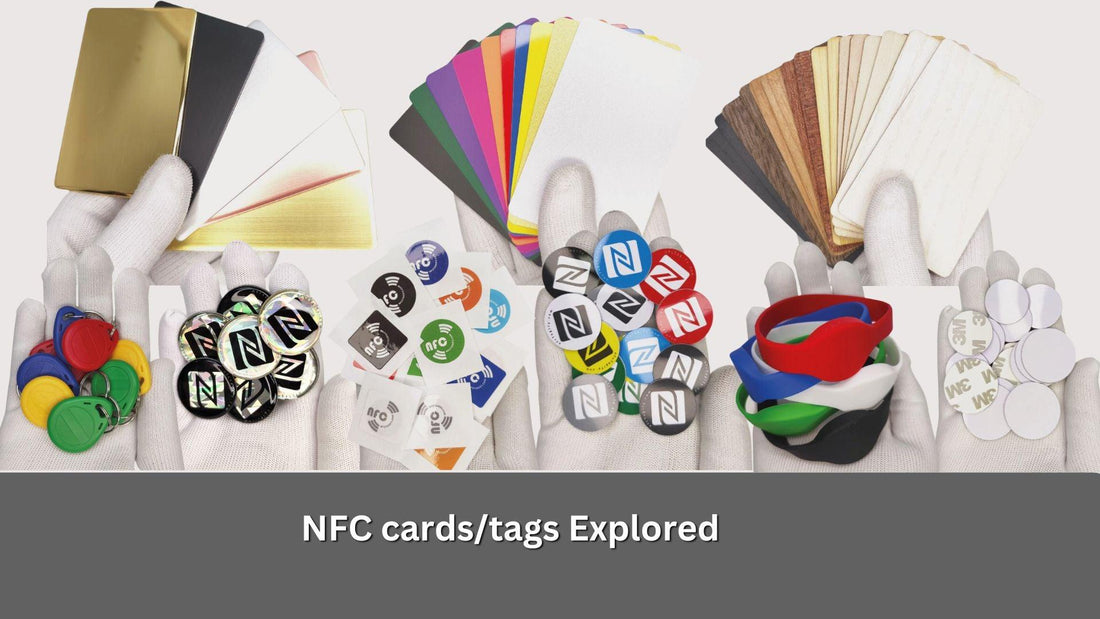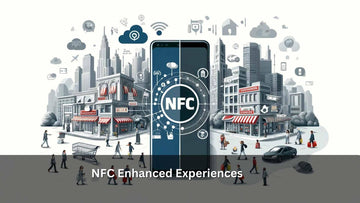NFC cards/tags Explored

-
What Is NFC Technology and How It Works?
NFC technology, or Near Field Communication, operates on the principles of RFID technology to enable wireless communication between devices over short distances. Functioning at 13.56 MHz, NFC allows for the exchange of data between devices that are a few centimeters apart, fostering a secure and quick transmission environment. This interaction can occur in two modes: passive and active. In passive mode, one device, typically an NFC tag, does not generate its own radio waves but responds to an active device, like a smartphone, by modulating the existing electromagnetic field. Active mode involves two-way communication between devices, both of which can generate and respond to radio waves. This flexibility makes NFC versatile for various applications, including contactless payments, where a phone communicates with a payment terminal, and information sharing, where two phones exchange data directly. The ease of use, security features, and low power consumption of NFC technology have led to its widespread adoption in consumer electronics and beyond.
-
NFC Products in the Market
The landscape of NFC-enabled products is vast and varied, catering to both consumer and business needs with innovative solutions that streamline operations and enhance user experiences. Among these, NFC blank cards stand out for their versatility, allowing for personalization in uses ranging from access control to contactless payment and information exchange. Available in materials like PVC, these cards can be customized to fit the branding and functional requirements of any organization.
Another popular NFC product category includes soft stickers, which can be affixed to surfaces or items, turning them into smart, interactive points. These stickers come in colors like black and white, providing a discreet yet powerful way to embed digital interactions in physical spaces.
For personal use or small-scale distribution, NFC keyfobs and wristbands offer a portable and convenient way to carry digital data. These can serve as access tokens, payment devices, or digital business cards, providing a seamless link between users and their digital identities or permissions.
In the hospitality and retail sectors, the NFC table talker has emerged as a significant tool. These devices sit on tables in cafes, restaurants, and other venues, offering customers a quick and easy way to access menus, place orders, or even make payments simply by tapping their NFC-enabled smartphone against the talker. The demand for such NFC table talkers has surged, with businesses ordering them in bulk to modernize customer service and enhance operational efficiency.
Each of these NFC products—whether blank cards, soft stickers, keyfobs, wristbands, or table talkers—demonstrates the technology's flexibility and potential to transform everyday objects into interactive touchpoints, bridging the gap between the physical and digital worlds.
Visit NFC Tagify for NFC Blank Cards
Explore NFC Soft Stickers at NFC Tagify
Check Out NFC Keyfobs and Wristbands
Discover the NFC Table Talker for Businesses
-
Practical Applications and Data Capacity

-
NFC in the Manufacturing Industry
In the manufacturing sector, NFC technology serves as a powerful tool for enhancing operational efficiency, quality control, and supply chain management. NFC tags attached to components and products enable real-time tracking through the production process, facilitating easy inventory management and reducing the likelihood of errors. For quality control, technicians can quickly access detailed product specifications, maintenance records, or assembly instructions with a simple tap of an NFC-enabled device, streamlining the inspection process. Additionally, NFC aids in ensuring authenticity and preventing counterfeiting by embedding secure, tamper-proof digital certificates in products. This not only enhances security but also strengthens trust in the manufacturing chain, from production to end consumer. The adoption of NFC technology in manufacturing settings significantly contributes to the optimization of operations, offering a seamless bridge between digital data and physical objects.
-
Broad Uses of NFC Technology
Beyond manufacturing, NFC technology permeates various sectors, enhancing convenience and security. In retail, NFC enables contactless payments, reducing transaction times and improving customer experience. Healthcare benefits from NFC through patient tracking and management, where tapping a device can bring up patient records and medication schedules instantly. In transport, NFC simplifies fare payments and boarding processes for public transportation, promoting efficiency. Additionally, NFC's application in smart homes allows for effortless control of devices and access management, offering both convenience and enhanced security. The technology's versatility and ease of use make it a transformative tool across diverse fields, streamlining operations and enriching user interactions.
-
Comparing RFID and NFC
RFID and NFC technologies, while similar in their use of radio frequencies for communication, differ significantly in their range, connectivity, and applications. RFID, with its ability to operate over long distances, is ideal for inventory tracking and logistics, where items need to be scanned from afar. NFC, on the other hand, excels in close-range interactions, typically requiring a distance of 4 cm or less, making it perfect for secure transactions and data exchanges. NFC's inherent security features and ease of use make it preferred for contactless payments, smart tickets, and personal device connectivity. RFID's broader range and scalability suit large-scale tracking and identification tasks. Choosing between RFID and NFC depends on the specific requirements of range, security, and interaction type in each use case.
-
NFC Cards: Types
NFC cards come in a variety of materials, each offering unique benefits and the option for customization to include your own design, logo, or information. These include:
-
- Known for their durability and premium appearance.
- Ideal for exclusive applications where a distinctive and high-end feel is desired.
- Customizable with intricate designs or logos, making them stand out as business cards or elite access passes.
-
- The most popular choice due to their perfect balance between cost-effectiveness and robustness.
- Suitable for a wide range of applications, from payment systems to identity verification.
- Offer flexibility in customization, allowing for a variety of designs, logos, and information to be printed or encoded.
-
- Offer an eco-friendly alternative with a unique aesthetic and texture.
- Stand out for their natural look, catering to environmentally conscious brands or events.
- Customization options include engraving or printing, providing a distinct and sustainable choice for those looking to differentiate their offering.
Each type of card allows for extensive personalization, ensuring that the final product aligns with your branding or specific informational needs, making NFC technology not just functional but also an extension of your brand identity.

-
NFC: From Origins to Future Horizons
NFC technology, tracing its roots back to RFID innovations, began shaping the digital landscape in the early 2000s through a collaborative effort by Philips and Sony. This partnership aimed to create a secure, contactless communication standard, propelling NFC to become a cornerstone for payments, data sharing, and smart device interconnectivity. As it stands, NFC's journey from a novel technology to an everyday utility sets the stage for its next leap. Looking ahead, the integration of NFC with IoT devices promises to revolutionize smart homes and urban infrastructure, further enhancing convenience and security. Advances in security protocols are poised to expand NFC's roles in secure transactions and personal identification, signaling a future where digital interactions are not just seamless but also inherently safer. This trajectory underscores NFC's evolving role in bridging the physical and digital worlds, making it an indispensable part of modern technology's fabric.
We at NFC Tagify provide all sort of NFC Solutions or you may contact us: Tel. 01600800080, Email: info@nfctagify.com








